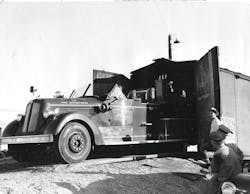Author’s note: To give our readers a sense of history regarding the non-firefighting world as it was 100 years ago this month, on June 28, 1914, a Serbian terrorist assassinated Archduke Franz Ferdinand, heir apparent of the Austria-Hungarian Empire, and his wife while they visited the Bosnian capital of Sarajevo. His death prompted the Austria-Hungary government to take action against Serbia. This initiated a complex series of events that eventually escalated into a world war.
CAMDEN, NJ: JUNE 6, 1914 – While operating at a working fire at Locust and Spruce Streets, Fireman Joseph Ware of Engine Company 1 was cranking the apparatus motor of Engine 3, when the crank slipped. Ware was struck in the face leaving him blind and paralyzed. Further complications from these injures led to his death the following month.
NEW YORK CITY: JUNE 10, 1914 – Eight lives were lost as flames swept through an old five-story tenement on Essex Street in lower Manhattan. Two alarms were transmitted for the fire, reported at 3:50 A.M. Before most of the tenants were even awake, dense clouds of smoke pumped into every hallway and apartment. There was only one staircase in the narrow building and it quickly filled with flames, forcing the occupants to find windows. The fire escapes filled with panicked people calling for help and clad only in their nightclothes. Fireman John Gillen of Hook & Ladder 6 was helping tenants from the fire escape when he saw a small boy, with his nightclothes burning, fall backward and disappear into his smoke-filled apartment. Gillen raced to the window, entered the scalding atmosphere and pulled the boy to safety, seriously burning himself during the rescue. Gillen was later awarded a medal for his heroism.
PHILADELPHIA: JUNE 13, 1914 – A boy was fatally burned, a score of people were injured and 11 two-story brick dwellings were destroyed as a result of a fire and explosion inside the Lubin Moving Picture Plant at 20th Street and Indiana Avenue. Thousands of feet of highly flammable movie film fed the blaze, filling the building with heavy smoke and extreme heat. Several movie actors and a professional boxer, being photographed at the time, battled the flames and rescued trapped workers until the firemen arrived. The loss was estimated at $1.5 million.
GLASGOW, SCOTLAND: JUNE 18, 1914 – A man emptying hot ashes into the water accidently let some fall on the deck of a schooner moored at the Kingston Dock in the middle of the city. The flames quickly reached some barrels of creosote stored on the wharf. Within minutes, a huge wall of fire engulfed the docks. Large sections of the docks, undermined by the flames, slid into the water. Huge cranes and thousands of feet of iron girders toppled as the burning pier structure lost its strength. Four schooners and hundreds of barrels of sea oil were also destroyed. The loss was in excess of $1.25 million.
WATERTOWN, NY: JUNE 18, 1914 – Driven by strong winds, a fire that started in a barn of the Burdick Coal Co. swept down River Street. Despite the valiant efforts of firemen, the fire leaped from building to building until five houses on the south side of the Black River were ablaze. The flames then jumped the river, destroying a half-dozen more buildings on that side. More than 20,000 tons of coal helped feed the flames. While firemen hurried back and forth across a bridge spanning the river, flames were consuming the planking of the bridge. All traffic eventually had to be halted as the bridge too burned. Firemen rescued a crippled man as the growing fire ignited his home.
SALEM, MA: JUNE 25, 1914 – At around 2 o’clock in the afternoon, a series of explosions caused by the mixing of acetone, alcohol, amalacitate and celluloid in a Boston Street leather factory ignited a fire that quickly spread out of control. Flames were soon leaping from building to building, even crossing Boston Street. Burning embers carried aloft by strong winds ignited fires in two other sections of the city. Calls for assistance were sent to all the neighboring communities. Late that evening, burning embers touched off a fire in the Salem Oil Co. plant on Mason Street. A tremendous explosion tore through the oil tanks destroying the plant and 13 homes. As reported in the Washington Post the following day: “The combined efforts of the greatest aggregation of fire-fighting machines ever seen here were futile, and when darkness fell dynamite was used.” In all, 1,376 buildings were destroyed, leaving 20,000 people homeless with half of them suddenly unemployed. This blaze became known as the Great Salem Fire.
PAUL HASHAGEN, a Firehouse® contributing editor, is a retired FDNY firefighter who was assigned to Rescue 1 in Manhattan. He is also an ex-chief of the Freeport, NY Fire Department. Hashagen is the author of FDNY: The Bravest, An Illustrated History 1865-2002, the official history of the New York City Fire Department, and other fire service books. His novels are available at dmcfirebooks.com. Hashagen is also a member of the Author’s Guild. Visit paulhashagen.com or Paul Hashagen-author on Facebook.
About the Author
Paul Hashagen
PAUL HASHAGEN, a Firehouse® contributing editor, is a retired FDNY firefighter who was assigned to Rescue 1 in Manhattan. He is also an ex-chief of the Freeport, NY, Fire Department. Hashagen is the author of FDNY: The Bravest, An Illustrated History 1865-2002, the official history of the New York City Fire Department, and other fire service books.
Connect with Paul
Website: paulhashagen.com
Facebook: Paul Hashagen-author
